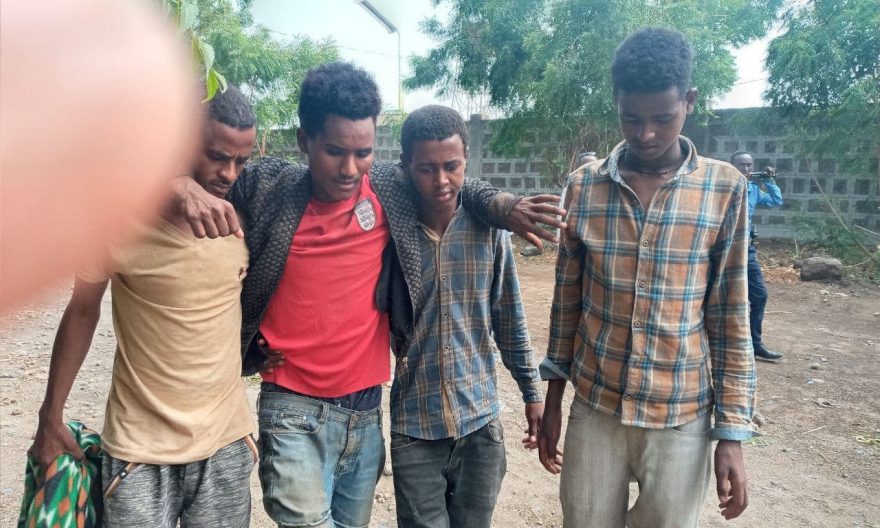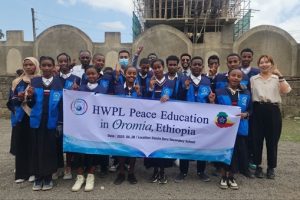
Whether or not particular forms of “work” can be called “child labor” depends on the child’s age, the type and hours of work performed, the conditions under which it is performed and the objectives pursued by individual countries. The answer varies from country to country, as well as among sectors within countries. The worst form of child labor involves children being enslaved, separated from their families and exposed to serious hazards and illnesses. They are left to fend for themselves on the streets of large cities, often at a very early age.Whilst child labor takes many different forms, a priority is to eliminate without delay the worst forms of child labor as defined by ILO convention on child labor. The TPLF in Ethiopia has notoriously executed the form of child labor by recruiting them as “soldiers.”
Work done by children is classified as child labor that is to be targeted for elimination. Children are forced to participate in work that seriously affects their health and personal development. It also interferes with their schooling and is generally regarded as being something negative. This kind of activity contributes to the underdevelopment of children. According to the ILO, the term “child labor” is related to work that deprives children of their childhood, their potential and their dignity. It is harmful to their physical and mental development. It refers to work that is mentally, physically, socially or morally dangerous to children. It deprives them of the opportunity to participate in child games. They are obliged to drop out of school prematurely. Child work requires them to engage in excessively long and heavy duties.
The worst forms of child labor include slavery or practices similar to slavery, such as the sale and trafficking of children. Forced or compulsory recruitment of children for use as soldiers in armed conflict is also the worst form of slavery. The procuring or offering of a child for prostitution, for the production of pornography or for pornographic performances are also dangerous ones. The use of a child for illicit activities, in particular for the production and trafficking of drugs as defined in the relevant international treaties is an offensive one. Child work, by its nature or the circumstances in which it is carried out, is likely to harm the health, or morals of children.
There are hazardous works which, by their nature or the circumstances in which they are carried out, are likely to harm the safety of children.
Guidance for governments on some hazardous work activities which should be prohibited is given by the ILO. It includes work which exposes children to physical, psychological or sexual abuse. It also includes working underground, under water, at dangerous heights or in confined spaces. It prohibits work with dangerous machinery, equipment and tools, or which involves the manual handling or transport of heavy loads.
The ILO guidance relates to work in an unhealthy environment which may expose children to hazardous substances, agents or processes, or to temperatures, noise levels, or vibrations damaging to their health. Also prohibited is work under particularly difficult conditions such as long hours or during the night or work where the child is unreasonably confined to the premises of the employer. Child workers, like child soldiers, are usually confined to labor camp, where they are offered meals the cost of which is deductible from their pay.
Child soldiers at the cross-fires: The voiceless victims of child labor are the child soldiers. In Ethiopia, the Tigray children are currently forced by the TPLF to engage in the cross-fires of a war front. These children face not only the dangers of combat, but suffer physical abuse or rape at the hands of the gang leaders. They are trained for less than a week on how to operate weapons and move in human waves. The UNICEF and other UN organizations have reported the massacre of children and women by the gangs. Yet, some of the international organizations are deliberately silent about such human rights violations, reflecting their support for the unlawful acts of the gang.
This act is against the ILO convention which highlighted the plight of child soldiers, and announced a program of rehabilitation for such children. It stressed that there is no greater challenge or more pressing charge than freeing the children who are caught in a conflict. It had organized a conference on “Children at the Crossfire,” to give it the attention it deserved. The ILO exposed that children on the front lines are servants of strife and victims of brutality. The question to be raised is why some of the UN agencies exist in name only?
Child soldiers are also the objects of violence and vengeance learning to kill, to harm and to destroy. This is what is happening in the Tigray region of Ethiopia currently, where they are driven by drugs to serve on the front lines. They are also exposed to horrors such as torture, assassinations, pillage and rape by those who forced them to fight in the frontline. They are armed with weapons of war instead of being armed with opportunity and hope. International conferences, on the other hand, recommended the global support to end the exploitation of child soldiers. UN agencies, governments and NGOs are well-informed through their representatives about children recruited to fight in battles about which they know nothing. These child warriors are subjected to fear, grief and violence which have marked their lives.
Field reports provide a horrifying picture of danger, fear, abuse and violence suffered by children in conflict in and around the Tigray region of Ethiopia. Children are either incorporated into armed bands known as “Samri” or coerced into fighting, or supporting armed gangs. Outright abduction is frequent, especially in the countryside. Boys are used as spies and sent to the camps of regular government forces to obtain information. The girls are used as domestic servants and sex slaves. Children who do fight are often massacred in combat. During combat, they used to hide behind rocks or trees to avoid danger just to avoid death. The reasons why these children become soldiers are often unclear. Outright abduction by rebel groups accounts for a high proportion of the recruitment of children into armed groups.
Double stigma: The child soldiers join the armed group risking their lives. They have no choice but follow the armed gangs to the battle front. At the same time, parents found it hard to feed these children due to shortage of food in the region. Looking for food, the children had to join the armed group. Families whose children could not join the gang are denied food rations. Despite the risks involved in escaping the horrors at the battle front, some children have managed to escape. Parents hope that their child soldiers may be demobilized or released through the intervention of divine power, God. It seems, however, that their ordeal does not end when they get away. Return to their Woreda or villages can be difficult as their communities have been victims of the conflict and see ex-combatants as responsible for the crimes of looting, torture and murder.
These communities may think of the returnee childrenas capable of committing crimes. Girl soldiers may have to overcome the “double stigma” of having participated in the conflict and of being unwed mothers. It is very unfortunate for the youth to have been forced to join armed struggle. Those who command the renegade armed force may face shortage of fighters at the battle front. They are, therefore, forced to snatch children from their parents and engage them at the battlefront. Without sufficient training, the child soldiers are placed at the battlefront to face professional soldiers that are heavily armed. These children have only two choices, either die or escape from the battle front.
Preventing child army: It is imperative to prevent the establishment of the army of children. Preventing the involvement of children in armed conflict requires absolute determination by the ILO in executing conventions related to children. These conventions have to be respected by governments and armed groups engaged in battles. Armed groups engage in forced recruitment of children or in abducting them to fight in battles without relevant training and knowledge of the objective of their engagements. This occurs due to lack of enforcement of relevant conventions and policies. Awareness raising, adopting and implementing of UN and ILO conventions and implementing them are critical to create peace in Ethiopia.
It is important to develop practical and targeted strategies to help children overcome their trauma and prepare them for a better future. These strategies include counseling, education, vocational training and assistance to parents to have access to decent jobs that boost their incomes. Also, a development strategy to overcome the root causes of poverty is very useful for keeping children in schools. A policy for the promotion of social and economic reconstruction is crucial for employment generation and poverty eradication. These measures would support communities to be more stable, more secure and peaceful. These would help rehabilitate and reintegrate former child soldiers back to their families and communities.
A comprehensive strategy may be developed with the ILO to help former child soldiers in Ethiopia. This may help educate former child soldiers and reintegrate them into the society. These children are not able to demand for their rights to have access to health, education, shelter, clothing and other services. It is the duty of humanitarian groups to address the root causes of child soldiers, such as the absence of basic human rights and fundamental freedoms. They should respect the convention on child labor that bans forced recruitment of children.
Conclusion: The armed gang in Ethiopia exploits child labor in different forms. Children dressed as young clerics and pastors preach about the grandeur, dignity and splendor of the rebel group. But, they tend to forget it had chastised, penalized and subjugated them when it was at the peak absolute power in the whole country. The same children also camouflage and disguise themselves as beggars and move around villages. They communicate with local people about the return to power of the armed gang in the immediate future. These children change their roles as they travel from one village to the other. They spy on the people and communicate back to the rebel group.
These children feel courageous under the influence of drugs and they fall back to fatigue and lethargy as its effects expire. The health and education of these child soldiers is seriously affected. They are deprived of their childhood. They are subjected to mental crises and physical deformity due to wounds they suffer in battles. They become anti-social and morally bankrupt. These children become dangerous and harmful to the community they live in. They are also aimless. However, it is imperative to respect international conventions on children to relieve child soldiers from hardships. They have to regain their rights and proper childhood care by all concerned entities, including the government and people of Ethiopia. It is crucial for Ethiopians to stand united with the government at this time of national crises that involves children.
Editor’s Note: The views entertained in this article do not necessarily reflect the stance of The Ethiopian Herald.
BY GETACHEW MINAS
The Ethiopian Herald 15 August 2021





